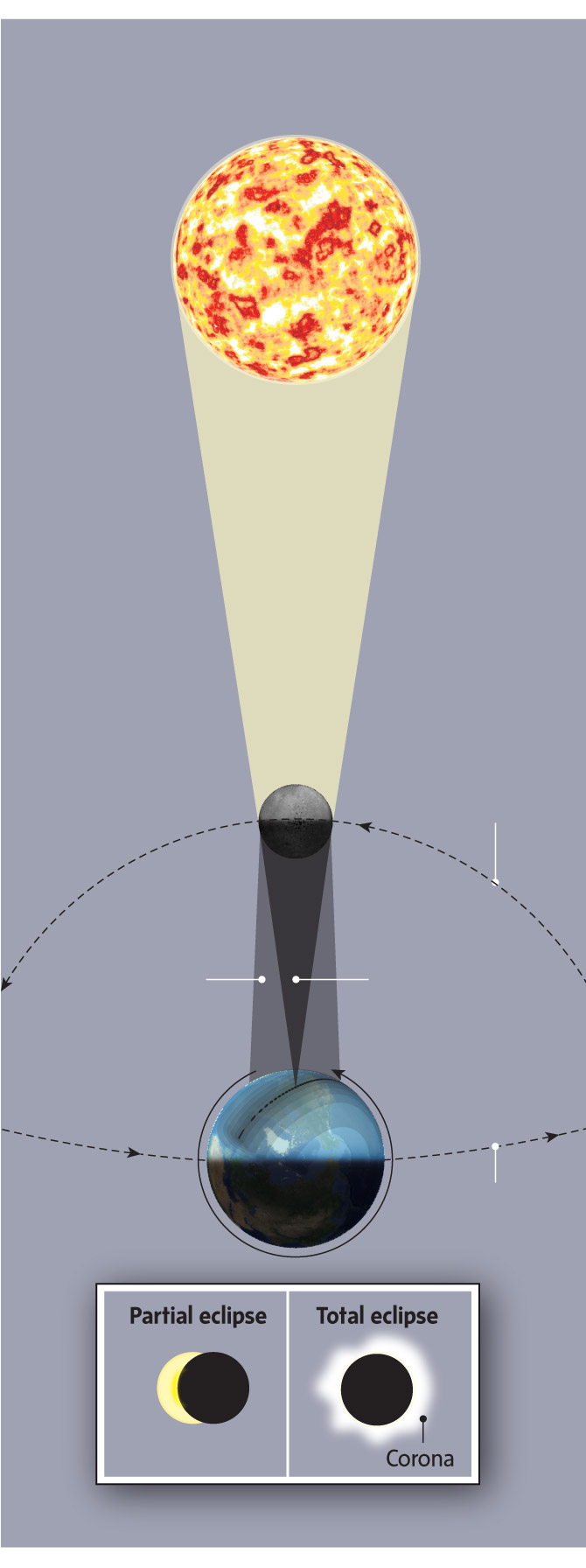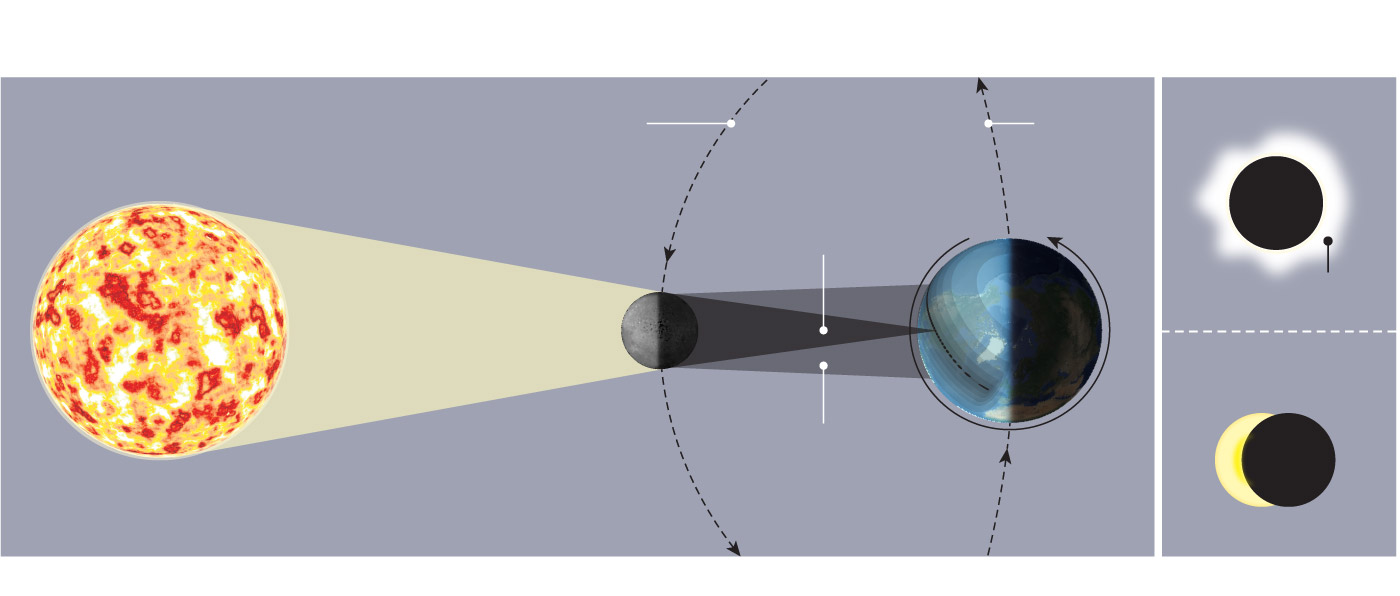Tyler Nordgren is a professional astronomer and artist. He earned a PhD in astronomy from Cornell University and has worked as an astronomer at both the U.S. Naval Observatory and Lowell Observatory. His books include Sun Moon Earth: The History of Solar Eclipses from Omens of Doom to Einstein and Exoplanets.
When I was nine years old I was cheated out of a life-changing experience.
In 1979, a total solar eclipse passed directly over my house in Portland, Ore., as the shadow of the moon swept off the Pacific Ocean and crossed parts of the Northwestern United States and Central Canada. At that age I loved space and wanted to be an astronaut. I was so excited to see the eclipse that I read every book I could find in my school library. I learned about the ghostly corona, the sun’s outer atmosphere, that streams off into space in all directions from the momentarily black disk of the sun, and is utterly invisible to us here on Earth except during the few precious minutes of totality. Yet the media focused so heavily on the dangers of looking at the sun that I assumed there must be some strange rays emitted at the moment of totality that would instantly render me blind. When the day of the eclipse, Feb. 26, finally came, I was so confused that I hid in my house with the curtains drawn and watched my first total solar eclipse on the TV, snapping photos of the screen as the house grew dark around me. I had to wait another 20 years before I finally got to see a total solar eclipse with my own eyes and realized what I would have seen if I had just gone to the window and looked outside.
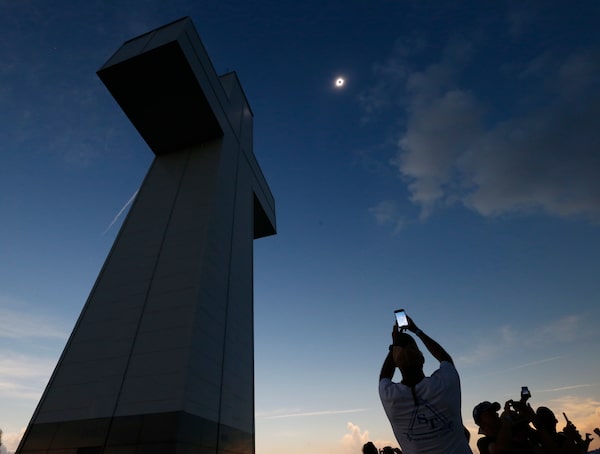
The sun goes dark above the Bald Knob Cross of Peace in Alto Pass, Ill., in 2017.Charles Rex Arbogast/The Associated Press
What I missed was an awe-inspiring spectacle that no photo or video can reproduce because a total solar eclipse isn’t just a visual phenomenon. It’s a fully immersive multisensory experience. While you can watch an eclipse on a computer or television screen, you’ll miss everything going on around you in the sky and on the ground around you.
When the moon covers the sun, the temperature plummets as the moon’s shadow sweeps over you at nearly 2,000 miles an hour. Birds go quiet as they return to their roosts while crickets chirp in the oncoming dusk. Colours change and are sapped of saturation from the landscape while shadows sharpen as if lit by a distant spotlight. In the moment before the sun is completely hidden by the limb of the moon, mysterious dim shadow bands ripple across bright surfaces in the otherworldly gloom. All these strange sensory inputs, some just barely treading the boundary of conscious perception, create an unsettling yet euphoric sense that something truly unnatural is taking place.
Meanwhile, overhead, as all of this is happening around you, the sun’s thin sickle, visible through eclipse glasses, shrinks noticeably while you watch. And then, in the final seconds, as that last tiny speck of sunlight is swallowed behind the moon in a phenomenon called the “diamond ring,” a single pure beam of light radiates out from a now coal-black moon surrounded by a pale, pearly radiance.
This is the moment of totality. Only at this moment is it safe, and necessary, to remove your eclipse glasses and see the sun turned black in a daytime sky the colour of cobalt surrounded on all sides by a strange sunset glow that rings the horizon. And streaming outward from the dark sun is that corona I read about when I was young. At a temperature of over a million degrees it’s the hottest thing any human being will ever see with their own eyes and is only visible for those who have made the journey into the path of totality. It’s one of the many reasons that settling for a 99-per-cent partial eclipse isn’t 99 per cent of the show. Make the effort to go to totality, and you will delight in those moments of darkness.
When I first saw totality – after 20 years of wondering what I had missed as a child – though I knew the science of what was happening, the hair still stood straight up on my neck and I knew the difference between knowing and feeling. It struck me, then, that all those years ago I missed a life-changing experience by not turning around and throwing the curtains wide and I cried – though I was grinning so hard my face hurt.
I realize that some of you reading this will not believe me, or accuse me of hyperbole. The world, after all, is full of false promises, whether it’s “one simple trick” to change your life or, these days, AI-generated wonders that pretend to be more real than reality. Scientists share in this blame. After all, how many times have you been told you cannot miss whatever super moon or meteor shower or comet is in the night sky?
However, an eclipse changes you. I experienced it again in 2017, after witnessing “The Great American Eclipse” on a ranch in Eastern Oregon with friends. Our eyes sparkled as we talked about the sense of connection we felt in our little valley under the trees. It was a connection not just to one another and those around us but to the universe. It was a connection made tangible as during totality the sun and moon were aligning not just with the Earth, but literally with each of us. And that connection, while individual, was also communal.
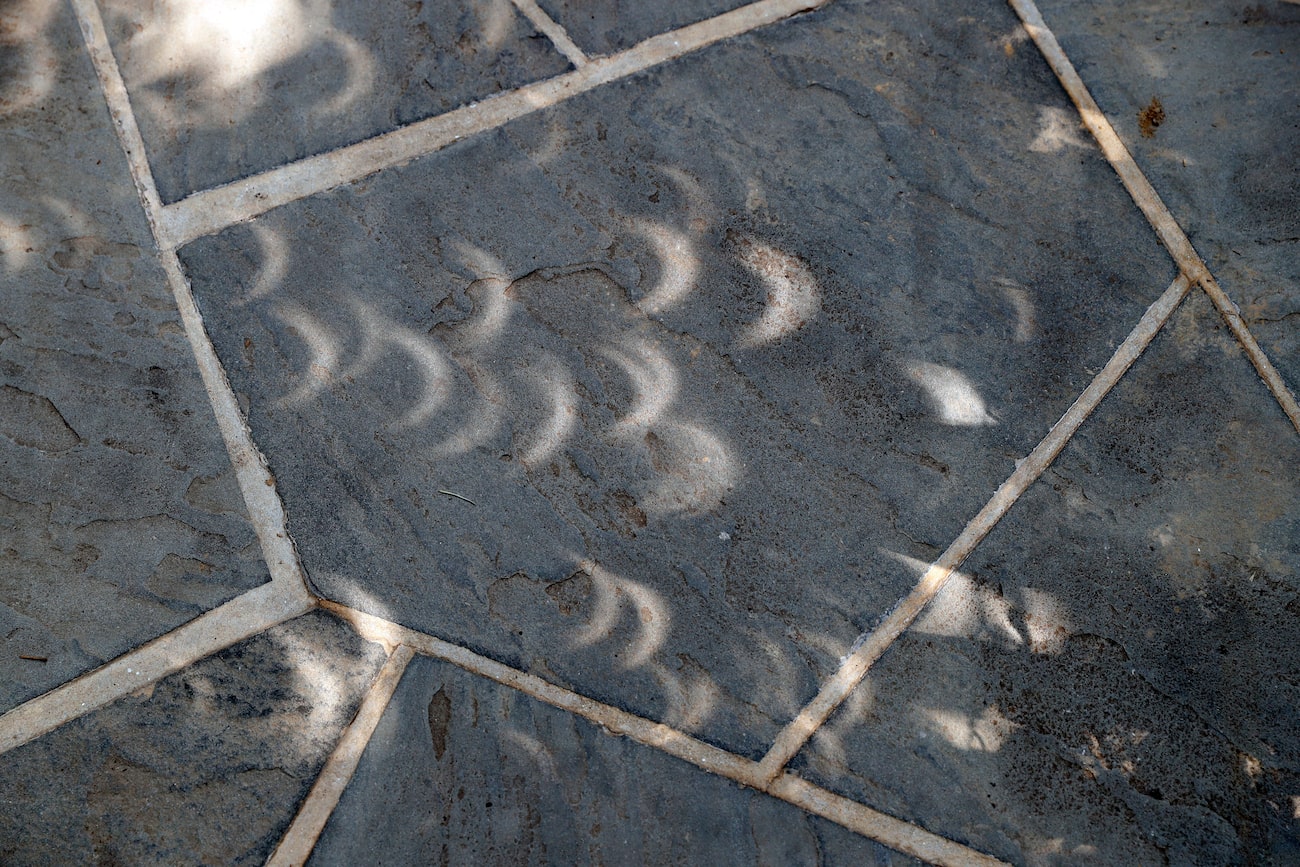
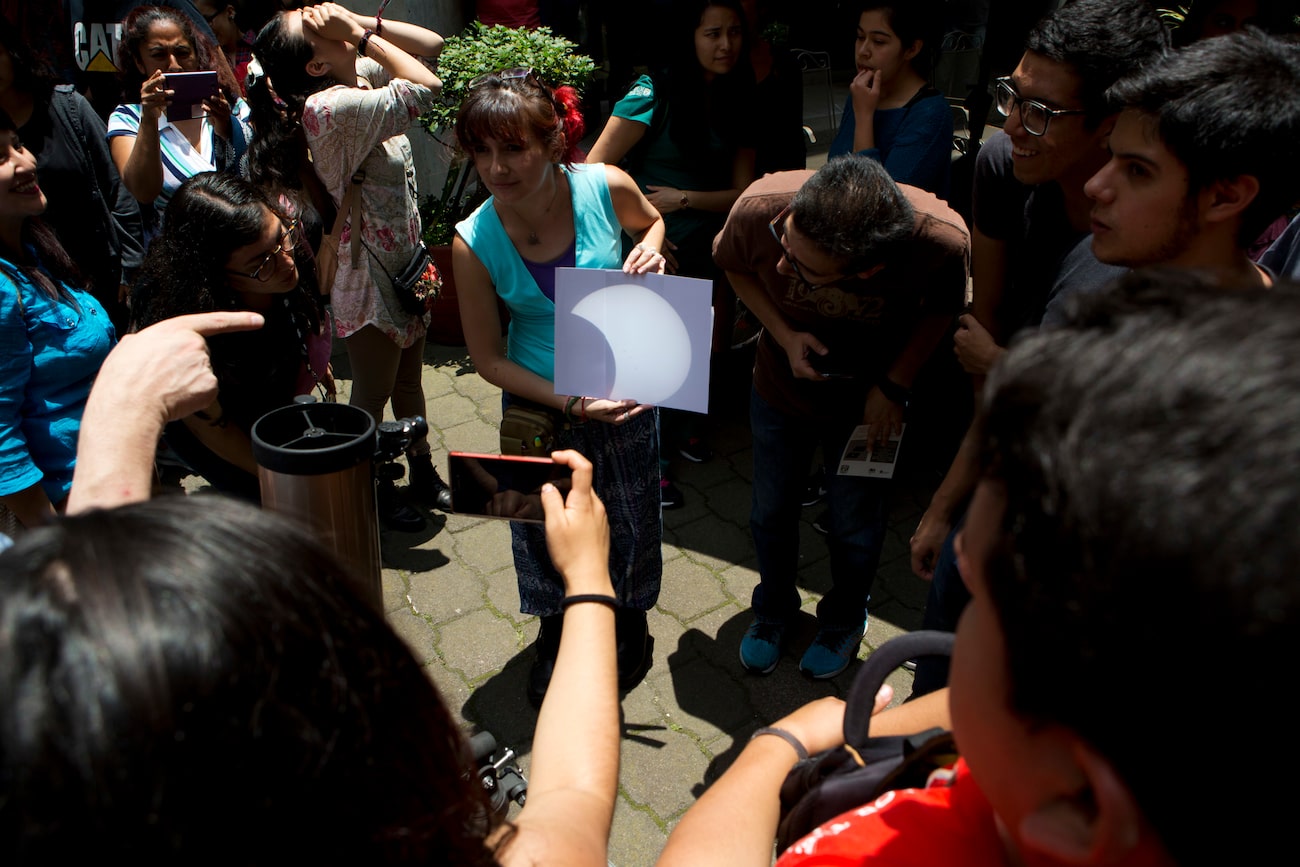
When we think of historic moments that bring us together, so many involve a triumph over adversity, be it a sporting, political or military victory. In each of these, a victor implies a vanquished. Yet in the moment of totality, there is no winning or losing, just sharing. And perhaps that is one reason why when I talk to those who have had this experience, the words they use are ones of togetherness.
The Australian psychologist and author Dr. Kate Russo studies this euphoria that those who experience a total solar eclipse feel. In her book Being in the Shadow, she says that a total solar eclipse doesn’t just happen above you, but around you and within you as well. Dr. Russo works with communities in the path of total eclipses around the world to help prepare them for what they will experience. And invariably the first question everyone asks after seeing their first eclipse is “When can I see another?” I’ve been told that the hours after an eclipse are when hotels in the path of the next eclipse, even if it is two, three or five years away, suddenly get calls from people wanting to book rooms, much to the mystification of the hotel clerk answering the phone or e-mail that day. Surely the fact that each eclipse creates a new generation of eclipse-chasers must attest to the power of totality to change lives. It’s the power of awe.
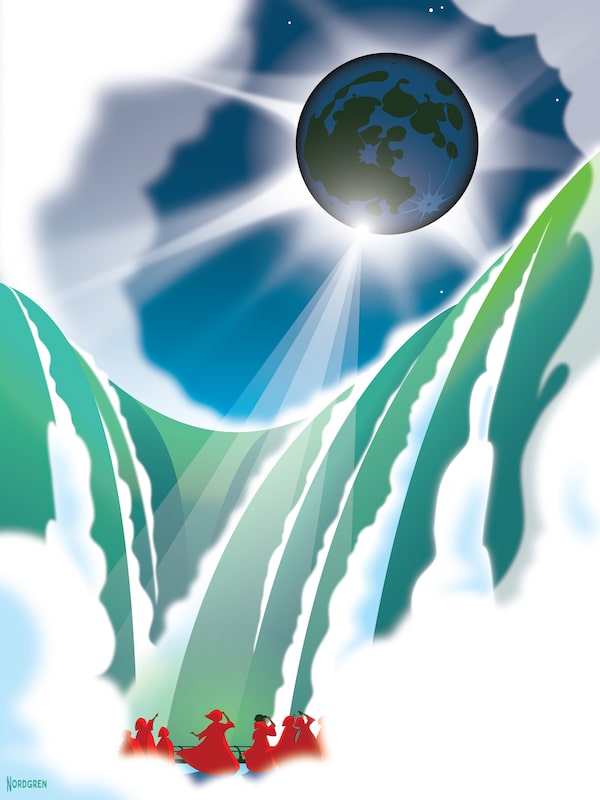
ILLUSTRATION BY TYLER NORDGREN
There is a growing movement to study the nature of awe and its effects on people. Dr. Jennifer Stellar, a professor of psychology at the University of Toronto, studies how communities thrive. In 2018 she and her colleagues published a paper concluding that those who experience awe feel greater humility. By feeling awe, the “wonder and amazement at being in the presence of something vast that transcends one’s current understanding,” Dr. Stellar wrote, we acquire a sense of humility in that we realize we are part of something greater than just ourselves, which leads to a deeper appreciation of, and empathy for, others.
Couple this realignment in our idea of self and our place in the universe, with the sudden visceral knowledge of our literal alignment with the cosmos that occurs during totality, and it’s no wonder that standing in the shadow of the moon creates a sensation within us more powerful than any photographic, video or written experience can encompass. And more importantly, it’s one with more lasting power for positive change in how we see ourselves and one another. When we open ourselves to the experiences that generate awe, be it the first time standing on the rim at Niagara Falls, or in the shadow of the moon, or on April 8, both simultaneously, we open ourselves to one another on an emotional level that is the first step in being better neighbours, better global citizens and, perhaps, better stewards of this world we share together.
Don’t believe me? Then join me in the path of totality on April 8 and experience for yourself what happens when the sun and moon align with you.
Map: Where Canadians can see the April 8 eclipse

(local times, p.m.)
ONT.
North
100 km
Toronto
Durations
30 seconds
U.S.
Hamilton
1 minute
Windsor
2 minutes
Niagara
Falls
3 minutes
Leamington
3:20
Central line
3:18
3:16
3:14 p.m.
(EDT)
Ottawa
Cornwall
Kingston
3:26
3:24
3:22 p.m.
(EDT)
PARTIAL
TOTAL
DURATION
PARTIAL
ECLIPSE
ECLIPSE
OF
ECLIPSE
BEGINS
BEGINS
TOTALITY
ENDS
Ontario
Leamington
1:58:39
3:13:43
2m 2s
4:28:04
Hamilton
2:03:56
3:18:12
1m 53s
4:31:12
Niagara Falls
2:04:53
3:18:20
3m 30s
4:32:00
Fort Erie
2:04:47
3:18:12
3m 44s
4:32:02
Kingston
2:09:32
3:22:16
3m 2s
4:34:28
Cornwall
2:12:35
3:25:01
2m 11s
4:35:58
North
Quebec
100 km
QUE.
Montreal
Lac-Mégantic
3:32
3:30
3:28 p.m.
(EDT)
PARTIAL
TOTAL
DURATION
PARTIAL
ECLIPSE
ECLIPSE
OF
ECLIPSE
BEGINS
BEGINS
TOTALITY
ENDS
Quebec
Montreal
2:14:29
3:26:55
1m 17s
4:36:52
Drummondville
2:16:07
3:28:32
35s
4:37:40
Sherbrooke
2:16:37
3:27:43
3m 25s
4:38:16
Lac-Mégantic
2:18:01
3:28:47
3m 27s
4:38:58
North
100 km
N.B.
Grand Falls
Les Îles-de-la-Madeleine
4:34 p.m.
(ADT)
4:36
4:40
Tignish
Fredericton
PEI
Moncton
Charlottetown
PARTIAL
TOTAL
DURATION
PARTIAL
ECLIPSE
ECLIPSE
OF
ECLIPSE
BEGINS
BEGINS
TOTALITY
ENDS
New Brunswick
Grand Falls
3:22:45
4:33:06
1m 27s
5:40:49
Hartland
3:22:43
4:32:24
3m 21s
5:43:13
Fredericton
3:23:43
4:33:50
2m 16s
5:41:55
Miramichi
3:25:27
4:34:24
3m 09s
5:42:15
Prince Edward Island
Tignish
3:27:12
4:35:45
3m 11s
5:43:10
Summerside
3:27:23
4:37:08
1m 04s
5:43:32
North
100 km
N.L.
Gander
5:14 p.m.
(NDT)
Bonavista
5:18
Clarenville
Channel-Port
Aux Basques
PARTIAL
TOTAL
DURATION
PARTIAL
ECLIPSE
ECLIPSE
OF
ECLIPSE
BEGINS
BEGINS
TOTALITY
ENDS
Newfoundland and Labrador
Channel-Port
4:02:52
5:09:59
2m 45s
6:15:26
Aux Basques
Gander
4:07:27
5:12:50
2m 13s
6:16:29
Clarenville
4:08:11
5:13:38
2m 31s
6:17:11
Bonavista
4:08:52
5:13:43
2m 53s
6:17:07
MURAT YÜKSELIR / THE GLOBE AND MAIL, SOURCE:
NASA; OPENSTREETMAP; FRED ESPENAK,
RASC OBSERVER’S HANDBOOK

(local times, p.m.)
ONT.
North
100 km
Toronto
Durations
30 seconds
U.S.
Hamilton
1 minute
Windsor
2 minutes
Niagara
Falls
3 minutes
Leamington
3:20
Central line
3:18
3:16
3:14 p.m.
(EDT)
Ottawa
Cornwall
Kingston
3:26
3:24
3:22 p.m.
(EDT)
PARTIAL
TOTAL
DURATION
PARTIAL
ECLIPSE
ECLIPSE
OF
ECLIPSE
BEGINS
BEGINS
TOTALITY
ENDS
Ontario
Leamington
1:58:39
3:13:43
2m 2s
4:28:04
Hamilton
2:03:56
3:18:12
1m 53s
4:31:12
Niagara Falls
2:04:53
3:18:20
3m 30s
4:32:00
Fort Erie
2:04:47
3:18:12
3m 44s
4:32:02
Kingston
2:09:32
3:22:16
3m 2s
4:34:28
Cornwall
2:12:35
3:25:01
2m 11s
4:35:58
North
Quebec
100 km
QUE.
Montreal
Lac-Mégantic
3:32
3:30
3:28 p.m.
(EDT)
PARTIAL
TOTAL
DURATION
PARTIAL
ECLIPSE
ECLIPSE
OF
ECLIPSE
BEGINS
BEGINS
TOTALITY
ENDS
Quebec
Montreal
2:14:29
3:26:55
1m 17s
4:36:52
Drummondville
2:16:07
3:28:32
35s
4:37:40
Sherbrooke
2:16:37
3:27:43
3m 25s
4:38:16
Lac-Mégantic
2:18:01
3:28:47
3m 27s
4:38:58
North
100 km
N.B.
Grand Falls
Les Îles-de-la-Madeleine
4:34 p.m.
(ADT)
4:36
4:40
Tignish
Fredericton
PEI
Moncton
Charlottetown
PARTIAL
TOTAL
DURATION
PARTIAL
ECLIPSE
ECLIPSE
OF
ECLIPSE
BEGINS
BEGINS
TOTALITY
ENDS
New Brunswick
Grand Falls
3:22:45
4:33:06
1m 27s
5:40:49
Hartland
3:22:43
4:32:24
3m 21s
5:43:13
Fredericton
3:23:43
4:33:50
2m 16s
5:41:55
Miramichi
3:25:27
4:34:24
3m 09s
5:42:15
Prince Edward Island
Tignish
3:27:12
4:35:45
3m 11s
5:43:10
Summerside
3:27:23
4:37:08
1m 04s
5:43:32
North
100 km
N.L.
Gander
5:14 p.m.
(NDT)
Bonavista
5:18
Clarenville
Channel-Port
Aux Basques
PARTIAL
TOTAL
DURATION
PARTIAL
ECLIPSE
ECLIPSE
OF
ECLIPSE
BEGINS
BEGINS
TOTALITY
ENDS
Newfoundland and Labrador
Channel-Port
4:02:52
5:09:59
2m 45s
6:15:26
Aux Basques
Gander
4:07:27
5:12:50
2m 13s
6:16:29
Clarenville
4:08:11
5:13:38
2m 31s
6:17:11
Bonavista
4:08:52
5:13:43
2m 53s
6:17:07
MURAT YÜKSELIR / THE GLOBE AND MAIL, SOURCE:
NASA; OPENSTREETMAP; FRED ESPENAK,
RASC OBSERVER’S HANDBOOK
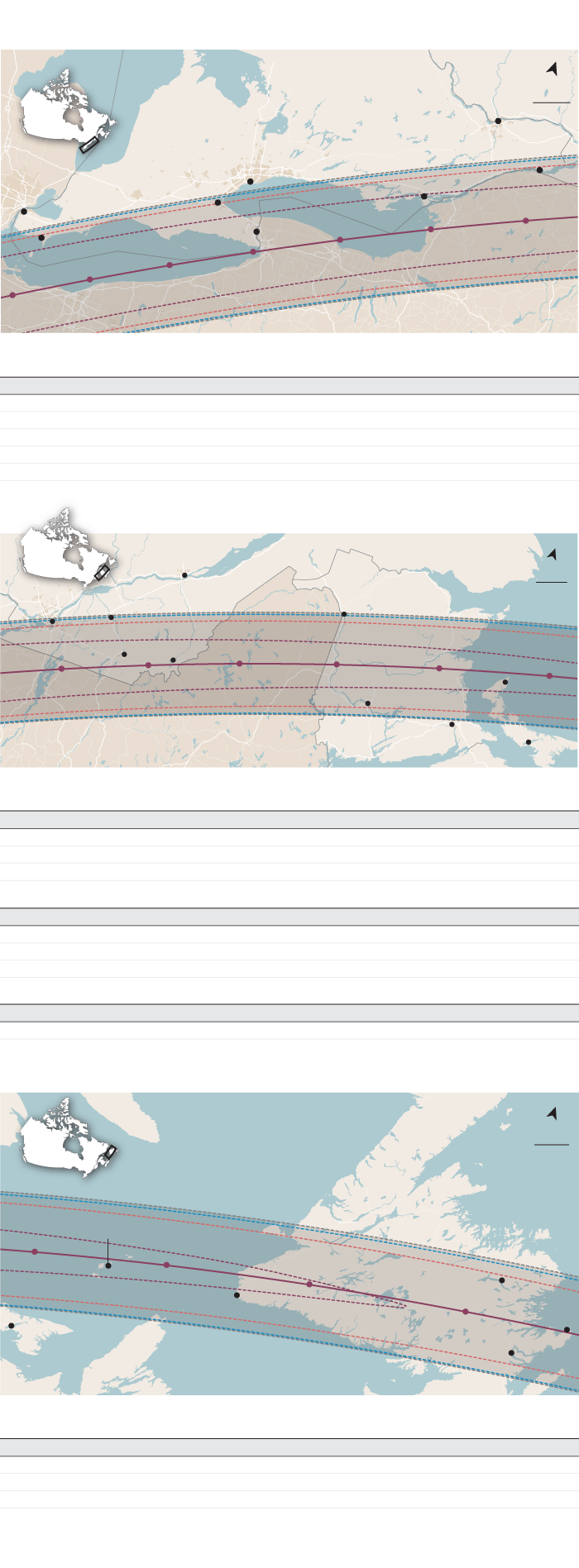
(local times, p.m.)
North
50 km
CANADA
Ottawa
ONT.
Cornwall
Toronto
Durations
30 seconds
U.S.
Kingston
1 minute
Hamilton
Windsor
2 minutes
3 minutes
3:26
Niagara Falls
Leamington
3:24
3:22
3:20
Central line
3:18
3:16
3:14 p.m.
(EDT)
PARTIAL
TOTAL
PARTIAL
ECLIPSE
ECLIPSE
DURATION OF
ECLIPSE
BEGINS
BEGINS
TOTALITY
ENDS
Ontario
Leamington
1:58:39
3:13:43
2m 2s
4:28:04
Hamilton
2:03:56
3:18:12
1m 53s
4:31:12
Niagara Falls
2:04:53
3:18:20
3m 30s
4:32:00
Fort Erie
2:04:47
3:18:12
3m 44s
4:32:02
Kingston
2:09:32
3:22:16
3m 2s
4:34:28
Cornwall
2:12:35
3:25:01
2m 11s
4:35:58
North
Quebec
50 km
QUE.
N.B.
Montreal
Grand
Falls
Drummondville
Lac-Mégantic
Sherbrooke
3:32
4:34 p.m.
(AST)
3:30
4:36
3:28 p.m.
(EDT)
Tignish
Fredericton
PEI
Moncton
Charlottetown
PARTIAL
TOTAL
PARTIAL
ECLIPSE
ECLIPSE
DURATION OF
ECLIPSE
BEGINS
BEGINS
TOTALITY
ENDS
Quebec
Montreal
2:14:29
3:26:55
1m 17s
4:36:52
Drummondville
2:16:07
3:28:32
35s
4:37:40
Sherbrooke
2:16:37
3:27:43
3m 25s
4:38:16
Lac-Mégantic
2:18:01
3:28:47
3m 27s
4:38:58
New Brunswick
Grand Falls
3:22:45
4:33:06
1m 27s
5:40:49
Hartland
3:22:43
4:32:24
3m 21s
5:43:13
Fredericton
3:23:43
4:33:50
2m 16s
5:41:55
Miramichi
3:25:27
4:34:24
3m 09s
5:42:15
Prince Edward Island
Tignish
3:27:12
4:35:45
3m 11s
5:43:10
Summerside
3:27:23
4:37:08
1m 04s
5:43:32
North
50 km
Les Îles-de-la-Madeleine
4:40 p.m.
(ADT)
4:42
N.L.
Gander
5:14 p.m.
(NDT)
Channel-Port
aux Basques
5:18
Charlottetown
Bonavista
Clarenville
N.S.
PARTIAL
TOTAL
PARTIAL
ECLIPSE
ECLIPSE
DURATION OF
ECLIPSE
BEGINS
BEGINS
TOTALITY
ENDS
Newfoundland and Labrador
Channel-Port Aux Basques
4:02:52
5:09:59
2m 45s
6:15:26
Gander
4:07:27
5:12:50
2m 13s
6:16:29
Clarenville
4:08:11
5:13:38
2m 31s
6:17:11
Bonavista
4:08:52
5:13:43
2m 53s
6:17:07
MURAT YÜKSELIR / THE GLOBE AND MAIL, SOURCE: NASA; OPENSTREETMAP; FRED ESPENAK, RASC OBSERVER’S HANDBOOK
Eclipse basics: More from The Globe and Mail
Science reporter Ivan Semeniuk has been fascinated by eclipses since he saw one in Manitoba in 1979. On this episode of The Decibel, he explains what makes them so compelling and how Canadians can watch one safely on April 8. Subscribe for more episodes.

